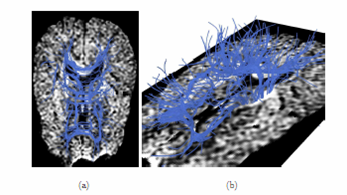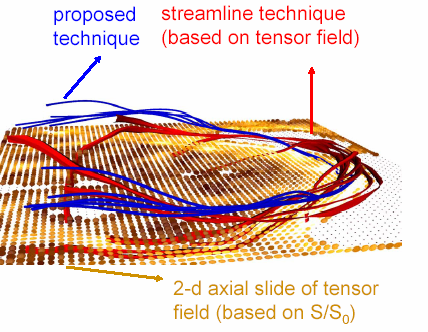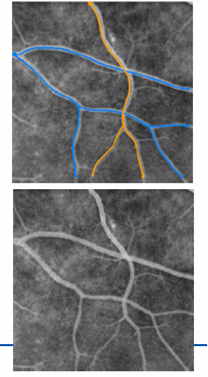Algorithm:GATech:Finsler Active Contour DWI
Back to NA-MIC_Collaborations
Objective:
We want to extract the white matter tracts from Diffusion Tensor MR data. The idea is to use directional information in a new anisotropic energy functional based on Finsler geometry.
Progress:
We have implemented the algorithm in matlab/C using the Fast Sweeping algorithm. We are in the process of porting the code to ITK.
We are continuing to work on our new framework for white matter tractography in high angular resolution diffusion data. We base our work on concepts from Finsler geometry. Namely, a direction-dependent local cost is defined based on the diffusion data for every direction on the unit sphere. Minimum cost curves are determined by solving the Hamilton-Jacobi-Bellman using the fast-sweeping algorithm. Classical costs based on the diffusion tensor field can be seen as a special case. While the minimum cost (or equivalently the travel time of a particle moving along the curve) and the anisotropic front propagation frameworks are related, front speed is related to particle speed through a Legendre transformation which can severely impact anisotropy information for front propagation techniques. Implementation details and results on high angular diffusion data show that this method can successfully take advantage of the increased angular resolution in high b-value diffusion weighted data despite lower signal to noise ratio. (See Figures 1 and 2 at the end of this page for examples. This method also works nicely for the segmentation of blood vessels as is indicated in Figure 3.)
- Working 3D implementation in Matlab using the C-based mex functions.
- Currently porting to ITK.
References:
- E. Pichon, J. Melonakos, S. Angenet, and A. Tannenbaum. Publication under review.
- E. Pichon and A. Tannenbaum. Curve segmentation using directional information, relation to pattern detection. In IEEE International Conference on Image Processing (ICIP), volume 2, pages 794-797, 2005.
- E. Pichon, C-F Westin, and A. Tannenbaum. A Hamilton-Jacobi-Bellman approach to high angular resolution diffusion tractography. In International Conference on Medical Image Computing and Computer Assisted Intervention (MICCAI), pages 180-187, 2005
Key Investigators:
- Georgia Tech: John Melonakos, Eric Pichon, Allen Tannenbaum
- Harvard/BWH: C-F Westin, Martha Shenton
Links:


